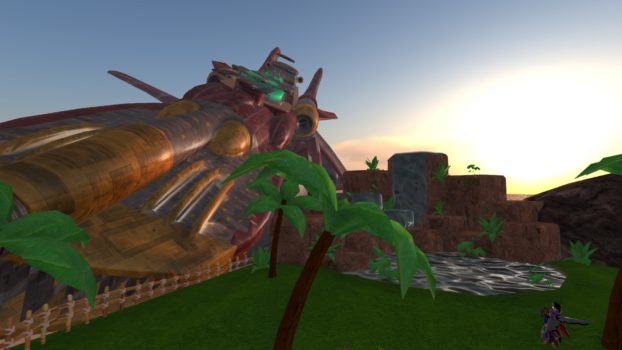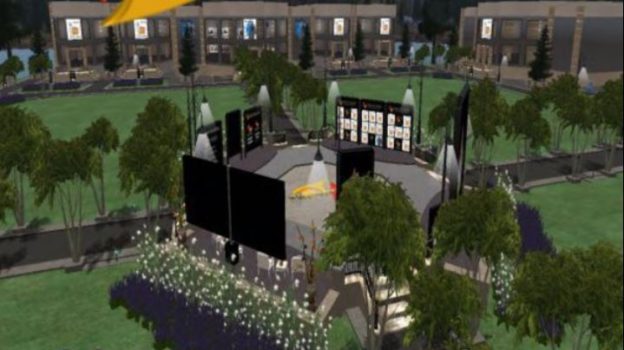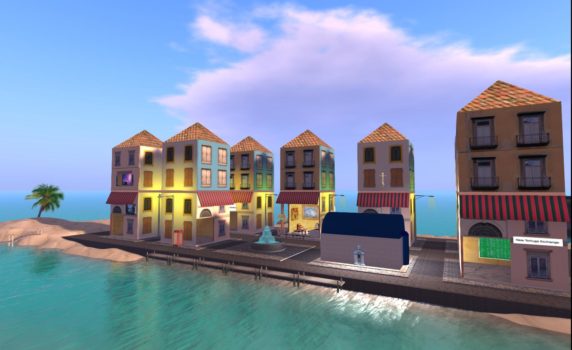
Twice as many grids now use Gloebit-powered payments compared to an older service, Podex, due to Gloebit’s easier set up and overall lower costs.
Gloebits reports that it now has close to 2,000 account users and is on more than 50 grids, and the cumulative value of transactions reached more than $10,000 last month.
Podex is implemented at 25 grids according to its owner, but only 24 are listed as options on its currency exchange page, and four of those are closed — Island Oasis, Venture Worldz, Sinful Grid and Konk Grid. Podex does not release any transaction data.
But the biggest advantage that Gloebit has over Podex is that it is universal. A single wallet can be used for shopping on any participating grid by either hypergrid teleporting over, or connecting multiple avatars to the same Gloebit account. And if one grid closes, the currency can still be used on all the other grids.
Podex supports single-grid currencies, which puts more control in the hands of the grid owners, but also makes it difficult for users to shop on multiple grids. Users have to buy multiple currencies, or use the Podex website to convert one currency to another.
On the other hand, Podex doesn’t collect a fee on individual transactions — Gloebit charges two percent. This has been a sticking point for some users considering Gloebit, while others say that they don’t mind because the overall costs are still lower and because it encourages grids to promote more commerce on their grids, since they get a share of those commissions.

Several grids also support both currency options, including DigiWorldz, Great Canadian Grid, Discovery Grid, 3rd Life Grid, Baller Nation, and Dynamic Worldz.
Overall, content creators and merchants get a better deal with Gloebits, former ZanGrid owner Suzan de Koning-Moennink told Hypergrid Business.

“When someone sells something that is costing 100 Gloebit, the creator will get 98 Gloebit,” she said. “Are we really making a fuss about two Gloebits — 0.784 cents? At the end, when we deduct fees for PayPal, fees for Gloebit and fees for grid owner, when the creator sells for 1000 Gloebits, he or she will lose 16 cents but when they sell 1000 Podex coins they will lose 80 cents.”
Now that she is running her Orchid Heights regions on the DigiWorldz grid, which offers region owners the choice of opting for Gloebits or Podex, she ran a test.
“I calculated the advantages of Gloebit above Podex,” she said. “For example, when I exchange in DigiWorldz 1,000 Podex coins into US dollars, I get $3.20 in my PayPal account. When I change 1,000 Gloebit into US dollars I get $3.92 on my PayPal. This is a difference of 72 cents.”
Grid owners who opt for Gloebit doesn’t get the benefit of being able to make money from selling their own currency — but they do get 1 percent commission on every transaction.
That could motivate the grid owner to promote Gloebits and offer more support for creators, she says.
ZanGrid, the grid she ran until she closed it down late last year, was one of the first grids to implement Gloebit and had the first hypergrid shopping mall.
“People from hypergrid visit us and shop there,” she said. “I think this is wonderful. A big improvement. Creators do not have to have separate shops on all different grids. It saves them time to maintain and they can spend more time in real life or creating. How inconvenient it would be if you being an American citizen have to put money on different banks in the states you like to visit only to be able to spend money in the state you visit. So why would we want this for OpenSim?”
Of course, region or grid owners who opt for Gloebit doesn’t have to accept hypergrid visitors if they don’t want to, she added.
“Gloebit only makes it possible for people from other grids to shop elsewhere and take their items back to their home grid, but this is all up to the creator,” she said.

Another enclave on DigiWorldz that was once its own grid is Pirate’s Atoll, and the owner announced a move from Podex to Gloebit earlier this month.
“Transitioning to Gloebit was super easy,” wrote John Simmons, also known as Strannik Zipper in-world. Simmons is a fan of the Bitcoin cryptocurrency, and users used to be able to convert Podex to Bitcoin on the YrGrid, but that connection is now gone. Plus, Podex has high exchange rates, he added.
“Gloebit is making a lot of headway in becoming a standard currency in the hypergrid,” he said. “They have stated their intent to allow cashouts in Bitcoin, barring a few technical difficulties.”
Now that he’s switched over, he was able to tip another artist on another grid without using PayPal, he said, “which is something that was not previously possible for me. That was a win.”
Other grids have also made the switch.

The Kaz Grid started out running its own currency system, using the TUIS DTL Money Server. It worked well, but its was limited to just that one grid, and hypergrid visitors couldn’t come in and spend money.
“In addition, it was a really hard system to set up, and when I upgraded to 0.9.0 there was not a TUIS DTL Money Server ready for this version,” grid owner Kazuko Yoshida told Hypergrid Business. “Then Gloebits came and it was very simple — just add one DLL file into the Bin folder, set the INIs up and it’s all go.”
For grid owners who don’t know what that means because they had someone else do their setup for them, they can ask their technology expert — or hosting provider — to make the change. Or, if they want to do it themselves, Gloebit will help them through the process.
Plus, users can have test regions where transactions are all play money. Yoshida says that this is excellent for developing money scripts. Also, Gloebits provides “always timely and most helpful” support, she added.
Podex doesn’t require a change to the money module, because it uses the grid’s own existing currency system. But that means that grids have to have their currency system set up in the first place.
Overall, Podex is more complicated to set up and use than Gloebits, confirmed Olivier van Helden, owner of Speculoos grid.
Some grids have been with Gloebits from the start.
AnSky Grid has been using Gloebits and never tried Podex, AnSky grid owner Andrew Simpson told Hypergrid Business. It was easy to set up Gloebits system, he said, but it does requires the creation of a user ID on the platform.
DigiWorldz hedges its bets
On DigiWorldz, Podex is the default currency platform grid-wide, but region owners can opt for Gloebits on their land if they want.

“For DigiWorldz specifically, the only challenge we had technically was to incorporate a way to automate the process of implementing one versus the other each time a region is started as our system had been designed to only work with one type of in world currency previously,” DigiWorldz owner Terry Ford told Hypergrid Business. “Once the process was modified to allow choosing between one or the other, we had no issues at all.”
He says neither currency is better than the other from a technical standpoint as far as their grid is concerned. However, for the user, it would depend on their opinions and expectations.
“As far as costs, it seems users have differing opinions on which is better and each type of currency seems to have its backers or defenders,” he said. “My personal point of view is that I prefer a global solution which works on all grids. While my avatar can use either, some users prefer one over the other due to their own opinions. I don’t prefer one over the other as they both allow me the ability to purchase in regions when I need to.”
Some grids are sticking with Podex
While several of the grids that Podex lists on its website no longer support Podex, or use in conjunction with Gloebits, or are no longer active, some grid owners say that they are happy with their service.
Podex has been around since 2007, so grid owners are more familiar with the platform.
GreekLife has been using Podex for about five years now and says that everyone in their grid is happy with Podex.
“I tested Gloebit for one of my regions for about one month but I don’t like Gloebit because for every transaction in-world Gloebit gets a fee,” a GreekLife grid spokesperson told Hypergrid Business.
Which one is more respected?
When it comes to virtual currencies, trust is crucial. Too many OpenSim users have been burned when their grids closed or had problems with their payment systems.
Gloebit is founded by Christopher Colosi, who used to run the Second Life Marketplace and the Lindex exchange. He is also pitching Gloebits as a currency to non-OpenSim platforms and online games and virtual reality apps, and the broader the user base, the more stable the currency.
Plus, since Gloebit is a grid-agnostic platform, if any one grid shuts down, the currency can still be accepted on all other grids that support it.
Podex, while officially incorporated in the U.K., is operated from Poland, and the owner, Jacek Shuftan, doesn’t have the same kind of name recognition as Colosi does.
Podex is also currently embroiled in a scandal with one of its customers, the GeVolution grid.
GeVolution has been using Podex for more than two years but that relationship has gone sour, according to their recent post. GeVolution claims that it loaned Podex one million in their grid’s currency in order to allow Podex to begin trading in it — and because the grid wanted to use their currency in other grids. Podex was to pay back in a share of its monthly profits per month to the grid, but that didn’t work out.
Podex CEOÂ Jacek Shuftan declined to comment about the specific allegations, but blamed GeVolution for the communication breakdown and denied that there was a law suit in progress.

“Podex has over 10 years’ history and that is a kind of guarantee that users will get their funds back if they want to cash out,” he told Hypergrid Business. “Podex guarantees that all the coins which were sold will be bought from users as long as grid owners plays fair — for example, do not close the grid without prior notice.”
That’s not actually much of a guarantee, since grids shut down all the time — and who decides that the grid is “playing fair”?
After all the hassles, GeVolution grid owner Cliff Hopkins says he’s down on third-party currencies in general.
“As a result of this I am no longer looking into bringing Gloebits in as I am worried that this will happen again,” he told Hypergrid Business. “Grids have zero safety against currency they do not control.”
He said he plans to launch his own currency, and is testing it now.
Of course, grids have had problems with their own currencies, as well — and not just with complaints from residents about not being able to shop on other grids.
For example, they have to have fraud protection mechanisms in place. Avination, once one of OpenSim’s most successful commercial grids, lost $126,000 to fraud and never fully recovered, shutting down a year ago. Plus, grids who have European users now have to comply with new European privacy regulations — outsourcing the currency to a third provider like Gloebit helps alleviate some of that burden.
The GeVolution situation isn’t the only problem that Podex has faced recently.
In December, Podex ran into problems with its support of YrGrid’s Bitcoin-based currency. Bitcoin prices spiked and users could not get their transactions completed and were placed as pending for many weeks. Some accused Podex or the YrGrid grid owners for wanting to cash in on the rising Bitcoin prices. Podex had to turn off support for the YrGrid currency and it is no longer available as a trading option on its website.
How much do the two platforms cost?
Turns out, this is a really difficult question to answer because the two platforms have different ways to make money from the currencies as well as different factors that determine the cost for users.
But, to summarize, Podex costs more to buy and sell, and Gloebit costs more for individual transactions. Overall, Gloebit seems to be cheaper.
At Podex, the merchant’s selling rate is 75 percent of the buyer’s buying rate for the largest bundle while at Gloebit, the merchants selling rate is 92Â percent of the buyer’s buying rate for the largest bundle.
So Podex keeps more of the money from currency sales. You can see the Podex exchange rate table here.
Buying 1,000 Gloebits will cost around $4.99 for the smallest and second smallest bundle according to Gloebit while buying 1000 coins on the largest bundle will cost $4.30. Buying 1,000 coins at Podex will cost around $4. However, if a merchant is selling the same number of coins, they will get more with Gloebits, at around 8 percent margin compared to Podex’s 25 percent margin on the largest bundle.
“On Gloebit, the margin varies as the buyer gets a better rate for purchasing more currency at one time,” said Gloebit’s Colosi. “A user who purchases our largest bundle is only paying eight percent as compared to what a merchant can sell those Gloebits for. That’s less than one third of the fee rate of Podex.”
In other words, Gloebit’s largest bundle of 11,500G costs $49.99 with a 15 percent bonus. If the person — a merchant — buys the bundle to resell, he would sell the Gloebits at the rate of 250G for $1, which translates to $46, which is eight percent lesser than what he bought the Gloebits for. In comparison, when the currency is bought via Podex, the margin at Podex is 25 percent, which means Gloebits is about a third cheaper. The margin varies as the buyer gets a better rate for purchasing more currency at one time.
However, Podex does not charge for transactions between avatars or when a user wants to buy coins from one grid using coins from a different grid.
“We do not charge for transactions between avatars on the grid, and I find it the main difference between Podex and Gloebit business idea, apart from the fact that Gloebit software needs to be implemented on the grid,” CEO of Podex Jacek Shuftan told Hypergrid Business.
Gloebit, as mentioned earlier in this article, charges 2 percent for in-world transactions.
Gloebit’s Colosi says that Gloebit’s services are already inexpensive compared to other microprocessors and they do not plan to change their rates.

“We don’t have any near term plans to change our pricing,” he told Hypergrid Business. “Gloebit is very inexpensive, and our customers feel that the quality of service is well worth those low costs, as evidenced by our expansion.”
Both platforms have policies and procedures in place to deal with fraud.
The standard limit at Podex is about $200 per day when buying and $150 per week when selling but it depends on the grid.
“If Podex is the only seller, the limit can be high because the risk that a fraudster will escape with money is low,” said Shuftan.
What does it actually take to set up the platforms
Although grid owners tell Hypergrid Business that Gloebits are easier, Podex argues that its platform is simpler for grids to use because it does not require any implementations from the grid owner’s side.
However, grids that opt for Podex still have to have an in-world currency system of some kind in place. So if they already have a currency, then adding Podex support is simple — but if they don’t already have a currency, then they have to go through that implementation on their own.
The way Podex works is that Podex creates an avatar on the grid, then uses that avatar account to buy and sell the grid’s virtual currency, and sets up an ATM to trade with other in-world residents. This is similar to how third-party currency exchanges used to operate in Second Life.
Since users do not need to set up their own Podex accounts, there’s no additional verification step, said Podex’ Shuftan.
“For coin seller, if an avatar wants to exchange his coins for real money or transfer them to other grid, he just pays the orange ATM, gets link to web page where he writes in his PayPal address or chooses the grid and his avatar in other grid and that is all,” he said. “Money is sent to PayPal in maximum four business days, but usually it is much faster, the same or next day. If something goes wrong, such as if the user does not fill in the seller form, his coins are returned after a few minutes.”
“The only thing that grid owner is to do is to give me a small parcel where a Podex ATM can be rezzed,” he said. “The Podex system does not interfere with grid software so it does not need any changes in case of updates and so on.”
However, this also means that Podex isn’t tightly integrated into the grid’s functionality. With Gloebit, once a grid installs the money module and the region enables the currency, all the built-in functionality, such as shopping, buying currency through the viewer, giving money to friends, all happens in the Gloebit system without the grid or region owners having to worry about anything.
But there is a technical challenge for Gloebit users when the currency is used on a grid where other regions use other currency systems.
Whenever a user enters a region where Gloebit is being used a popup message will appear letting the user know the region is using Gloebits and will ask them to authorize its use in the region. If a user does not see the notice and if they are not yet a Gloebit user their balance will show as D$0.
“If the user had a Podex balance and now suddenly they see D$0 then they get confused, or may think something has happened to their Podex balance,” said DigiWorldz’ Ford. “If the user leaves the region and returns to a Podex-enabled region their balance will reappear. Once we explain the situation they understand, but at times this can cause some confusion to a user.”
He says Gloebits can improve its service by giving users the ability to authorize entire grids from a pull down box or other type of selector on the Gloebit website.
“One thing which is a pain to me is having to authorize when I visit a new grid,” he said. “I’d rather simply go to a website and choose which grids I want to allow ahead of time instead of doing it when I arrive in the grid.”
Gloebits is working on these and other issues, said Gloebit’s Colosi.
For instance, users complained, in our earlier article about Gloebits, of the persistent and numerous internal messages about how to buy Gloebits every time they logged. This has been stopped in their last summer update of the Gloebit money system. It was the most requested improvement, said Colosi.
Gloebit will also be making some more improvement in future release in relation to the insufficient funds flow functionality so that when a user attempts to purchase an item, the system can prompt them if necessary.
“If they have not authorized the grid, then we can prompt them to do so and link this avatar on this grid to their Gloebit account, and if they have authorized but don’t have enough Gloebits, we can prompt them to purchase more,” said Colosi. “We can then give grids the choice to remove the authorization or link request instant message that unauthorized users get every session.”
Gloebit is also still working on having all the currency functionality supported by all viewers. Firestorm and Alchemy have already adopted the latest commerce functionality patches. The hypergrid and multi-currency grid functionality simplifies the setting up currency on a grid. It even allows a hypergrid visitor to buy land and vastly improves the end-user commerce experience.
Grid and region owners can set up the system directly by following Gloebit’s configuration instructions or ask their grid hosting provider to do it for them.
Gloebit payments are even available for people running mini-grids using the Diva Distro or the DreamWorlds installer on their home computers or self-managed servers.
“Further simplifying setting up a commerce enabled grid, we determined how to run Gloebit on both the 0.8.2.1 and 0.9.0.0 Diva distributions and provided those customized Diva integration instructions,” said Colosi. “We then also worked with OutWorldz, who I believe have incorporated Gloebit integration into their management system for DreamGrid beta. This work has resulted in us adding many small grids who see a lot of value in being part of a larger commerce ecosystem.”
Gloebit is also working on open-sourcing the money module so that outside developers can create new applications for it.
It will also allow Gloebits’ partners to help the company make improvements faster for OpenSim, to build directly against the version of OpenSim the partners are using when not a release, and to port the module for use on other virtual reality platforms and on the web according to Colosi.
“We have lots of features planned for our core service and website, but none so close that I’m ready to speak about them,” he said. “Open sourcing the money module is the priority right now and is getting our focus.”
Although the platform is relatively new, Colosi said that grid owners seem to be comfortable with the Gloebit system.
“If there are concerns, we’re not hearing about them,” he said. “Early on, I think there were more concerns because we were new. Now, we’ve been around for a while and many people trust us far more than most local grid currencies.”
- OpenSim active users hit all-time-high for the holidays - December 15, 2023
- OpenSim user activity ramping up for the holidays - November 15, 2023
- OpenSim land area at a new high as grids prep for holidays - October 15, 2023
